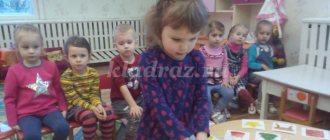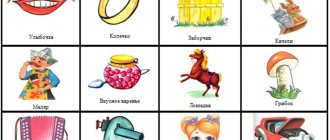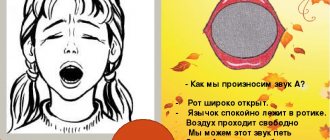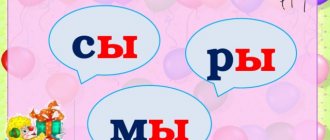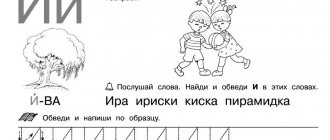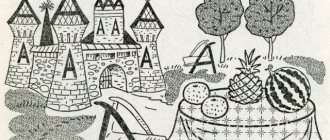Target.
Teach children to highlight the first consonant sound in a word;
introduce the letter Mm;
teach children to select action verbs for the proposed nouns; introduce a conventional (color) designation for hard consonants (blue) and soft consonants (green).
Equipment.
Pictures with sounds [m—m']; sticks; pictures of flowers; markers; sound houses.
Progress of the lesson
I. The teacher invites the children to meet one very interesting girl, Masha, and listen to a story.
1. — Once upon a time there lived Masha. Every day she came up with different games for herself. Today Masha woke up and thought: “Whatever sound I hear first, I’ll be friends with it all day long.” Masha went to the window and saw a cow and a cat. They sat opposite each other and talked. The cow mooed: “Moo-oo!” And the cat answered: “Meow!”
What is the first sound in a cow's song? ([m]).
What is the first sound in a cat's song? ([m']).
Masha smiled: “So today I’m playing and making friends with the sounds [m—m’].” Masha went to the kitchen where her mother was preparing breakfast. She told her mother: “You are the most important in my game, because your word has two sounds at once.”
- What two sounds did Masha mean? ([m]). Where in the word mother
can you hear the sound [m]? (At the beginning and middle of a word)
Masha went out into the garden. She wanted to pick a bouquet of flowers with the sounds [m—m']. Flowers grew in the flowerbed: irises, poppies,
peonies.
- What flowers do you think Masha picked? (Maki) Why? Masha returned with a bouquet of poppies.
I put them in a vase.
And on the table there was already semolina
porridge and
milk.
Masha laughed:
“Mommy,
what a great fellow you are!
You help me
in
my
game."
- Why did Masha say that? (In the words semolina, milk
- first sound [m]).
After breakfast, Masha went to the garden. We need to help mom prepare dinner. Masha
I picked
carrots
for soup,
raspberries
for compote.
- What is the first sound in the words carrot?
and
raspberries?
(Sound [m]).
Coming from the garden, Masha saw that there was pasta
and
meat
. The quick-witted girl realized that her mother would cook pasta the navy way.
— What sounds are heard at the beginning of the words pasta,
meat? (Sounds [m-m']).
Dad arrived at lunchtime. Seeing his daughter, dad asked: “What new game are you playing, Mashenka?”
“I play words with sounds [m—m'],” answered Masha.
“While mom is setting the table, I’ll play with you,” said dad, he sat Masha on his lap and began to ask her riddles. “I was driving through the field and saw this one with the sound [m] in the name:
Little animals
Gray fur coats,
Long tails
Little black eyes,
Sharp teeth. Who is this?" (Mice)
- Masha thought and guessed. Did you guess who Masha's dad saw?
“I brought you a toy. Guess it - it will be yours:
They beat him with a hand and a stick -
Nobody feels sorry for him.
Why are they beating the poor guy?
And because he’s inflated.” (Ball)
- Masha guessed this riddle right away. What about you, children?
2. Children, together with the teacher, compare the sounds [m-m'] in the words we sew
and
a ball.
It is determined that in the first word the sound is pronounced firmly, in the second word - softly.
Articulation of sounds.
When pronouncing sounds [m-m'], the lips are closed; there is an obstacle in the way of the air stream; the air stream seems to tear the lips.
The teacher agrees with the children that sounds whose pronunciation encounters obstacles in the mouth will be called consonants.
As can be seen from the examples, consonant sounds are hard and soft.
Characteristics of sounds.
Sounds [m-m'] - consonants; can be hard or soft.
II. 1. Sound analysis of words mouse
and
a ball
(with markers to color the windows in the houses).
2. Game situation “Focus”.
The teacher draws the children's attention to the diagrams of words on which the vowel sounds [m-m'] are painted over with a blue felt-tip pen.
— You and I discovered that consonants can be pronounced softly and firmly. But this is not visible in our diagram. How can we show that the sound [m] in the first word sounds hard, and in the second - soft, but the sun melted all its hardness?
The teacher takes a yellow felt-tip pen and paints over the blue square in the second word (as if a ray of sun had fallen on it). The blue square turns into green before the children's eyes. After this, a decision is made to designate soft consonants in green, and hard consonants remain blue. Red, as before, denotes a vowel sound.
III. Consolidation of new material.
1. The teacher offers to select and name from a pair of words those that begin with the sound [m'].
Example word pairs: oil
-
meat, poppy
-
ball, sea
-
stranded, mouse
-
bear, car
-
subway
, etc.
2. The teacher shows pictures with the sound [m] - the children select action verbs for them. For example: fly
-
flew, buzzed, got bored.
An approximate set of words: car (drove, stopped, carried), carrots (grew, turned green), pasta (lay, boiled, fried), mouse (ran, squeaked), boy (jumped, ran, drew, slept, played)
and etc.
IV. 1. Getting to know the image of a letter. The teacher asks the children:
- Do you think the sound [m] has its own sign - a letter? Does the sound [m'] have its own letter? I'll tell you the secret of our language: in Russian, hard and soft sounds are denoted by one letter. Now I will show you the letter that represents the sounds [m-m']. Display a demonstration letter and place it on the panel at the address: fourth floor (fourth row from the bottom), apartment No. 2 (second cell from the left). The flats for letters denoting consonant sounds are highlighted in blue.
2. Analytical and synthetic activities.
V. Game exercise “What elements does an object consist of?”
Goal: to train children in the ability to analyze an image and isolate its constituent elements.
The teacher draws schematic images of various objects (table, chair, snowman, etc.) on the board and asks them to answer the questions: what elements does the image of each object consist of? How many elements are there in total?
Group speech therapy lesson on the topic “Sounds [m], [m']. Letter M"
Sections: Speech therapy
Purpose of the lesson: to introduce the sounds [M], [M'] and the letter M.
Tasks: differentiation of sounds [M], [M'] by ear, familiarization with the image of the letter M; improving phonemic awareness, sound analysis and synthesis skills; development of fine motor skills, auditory attention, memory, prosodic aspects of speech; nurturing love and respect for your family.
Material: pictures: house, family, crown, cloud, bridge, snowball, sleigh, donkey, hammer, catfish, door, cucumber, car, carrot, stork, crane, poppy; sound houses, sound symbols, graphic representation of the letter “M”, individual mirrors, notebooks, counting sticks.
Progress of the lesson
Organizing time.
Psycho-gymnastics. Mimic exercises.
– What kind of facial expressions do mom and dad have when they are happy, sad, angry. Portray a joyful mom and an angry dad. Take a mirror, it will help you.
Breathing exercises. “Cooking porridge”
Our mother cooks porridge and feeds her daughter Masha with porridge.
I.p. – standing, one palm on the chest, the second on the stomach. Inhale through your nose, as you exhale say “puff-puff-puff” and stroke your stomach.
Report the topic of the lesson.
- Guys, guess the riddle:
Where is our family comfortable? Where does it smell like porridge in the morning? Cats' paws step there, And there are slippers at the entrance. (House)
The picture “House” is displayed.
– What is the last sound you hear in the word “house”? [M]. A family lives in this house. Listen to what consonant sound is in the middle of the word family [M']. ( The picture “family” is displayed)
– Today we will get acquainted with the sounds [M] and [M'], as well as with the letter “M”, which denotes these sounds.
Characteristics of the sounds [M], [M'] according to articulatory and acoustic characteristics.
– Take the mirrors, pronounce the sounds [M], [M'] alternately. What's happening to your lips? ( The lips close.
When we pronounce the sound [M], our lips become a little angry, and when we pronounce the sound
[M']
, they smile a little).
Does the air come out through the nose or through the mouth?
( Through the nose
).
Is the voice “sleeping” or “waking up”? ( Wakes up)
.
So what are the sounds [M], [M']? ( Consonants, voiced
).
The sound [M] is ( hard
), and [M'] is
(soft).
We denote the sound [M] with a (
blue
) square, [M'] – (
green).
Development of phonemic perception differentiation of sounds [M], [M'].
Game “Listen carefully”
– Now I’ll see how attentive you are. I will name the words, and if you hear the sound [M], raise the blue square, if [M'] is green.
Words: m
milk,
bear
,
bridge
,
hammer
,
compote
,
month
,
mouse ,
family
.
Analysis and synthesis of syllables with sounds [M], [M']
Game “Count the sounds”
– Listen, and count how many sounds I make, and use the symbol chips to make diagrams. Be careful: MA, AM, YM, WE, etc. (Children count and lay out patterns of syllables)
Game “Let's be friends.”
– You and I are already familiar with several vowel sounds. Name them ( a, o, y, s, and)
. Let's “make friends” with the sounds [M], [M']. I will name the vowel, and you add the sound [M], so that it comes first, and name the resulting syllable. A – MA, O – MO, U – MU, Y – WE. Well done! Now add the sound [M'], so that it is the second, and name the resulting syllable.
Determining the position of the sounds [M], [M'] in words.
– Let's come up with names with the sounds [M], [M'] for all family members ( Dima, Mitya, Maya, Masha, Mila, etc.
.) Determine where the sounds [M], [M'] are located in these words: at the beginning, in the middle or at the end of the word.
Working with sound houses
- How children can affectionately call their mother ( children's answers
).
What do you affectionately call your mother? ( Mommy, mummy, mummy, etc.
).
What did you notice when you said these words? (These owls have two sounds [M])
What is she like, your mother?
( kind, affectionate, sweet, etc.).
Physical exercise.
Now let's “charge up”
We stamp our feet: - Top - top - top. We raise our hands: - Clap - clap - clap. We will spread our hands and run in circles.
Development of phonemic representations.
Game “Guess the word”.
Progress of the game: The speech therapist offers the children cards with images of objects, the children must highlight the first sound of each word, and, alternately adding them, form a new word. First an example is given.
Cards: crown, cloud, bridge – com
sleigh, donkey, hammer -
catfish
door, cucumber, car -
house
, carrot, stork, crane -
poppy
Development of prosody.
– Mom bathed baby Mila and said the following words:
Mom washed Mila with soap
Mila didn't like soap.
(The clear speech is read on behalf of all family members in turn, with a change in timbre and strength of voice)
.
Introducing the letter “M”.
- Children, do you love your mothers? (Yes). To write this beautiful word, you need to get acquainted with the letter “M”. Look what the letter “M” looks like. (Children's answer options). Let's try to draw the letter “M” together.
Friends held hands. And they said: “You and I are us!” Meanwhile, the letter “M” turned out.
(Children join hands in pairs, depicting the letter “M”).
- Well done! You can also make the letter “M” from counting sticks.
Laying out the letter “M” from counting sticks.
Progress of the game: Children closed their eyes. The speech therapist removes one counting stick. Children must restore the letter “M”.
While your eyes were fast asleep, The letters in the book became smaller, Open your eyes What to add, guess! (Words by author)
Finger gymnastics “My family”
Clench your fingers into a fist. Then straighten them one by one, starting with the thumb.
This finger is grandpa, This finger is grandma, This finger is daddy, This finger is mommy, But this finger is me. That’s my whole family.
(To the words of the last line, rhythmically clench and unclench your fingers.)
Coloring letters in notebooks.
Summary of the lesson.
– What sounds did we get acquainted with? What letter are they denoted by?
Surprise moment. Game “Magic Box”.
– Children, today you called so many good, kind, affectionate words with the sounds [M], [M']. Let's remember them again and say them into our palms, and put them in a magic box. ( The speech therapist takes out multi-colored stars from the box
). Now guys, look, your words have turned into stars, this is gratitude for the good work in class.
- Pozhilenko E.A. The magical world of sounds and words A manual for speech therapists. – M.: Humanite. ed. VLADOS center, 2002
- Kartushina M.Yu. Logorhythmic activities in kindergarten. Method. manual - M.: Sphere shopping center, 2004.
- Novikova E.V. Articulation of sounds in a graphic image. Educational and demonstration material. – M.: Publishing house GNOM and D, 2003.
Sounds [M]-[Мь], letter M - summary of frontal lesson
Development of phonemic hearing.
Frontal lesson. Senior group ONR-III
First year of study (I period)
Topic: Sounds “M” - “M”. Letter M. Second lesson.
- Further differentiation of the concepts “sound-word”, “sound-letter”
- Clarification of auditory perception.
- Formation of phonemic representations.
- Development of phonemic analysis.
- Development of auditory-verbal memory.
- Object pictures, signals (symbols), ball, magnetic letters, chips
Lesson plan.
1. Organizational moment.
2. Game “Count the vowel sounds.”
- Raise as many fingers as you can hear vowel sounds (AU O AUI).
- What sounds were counted? (vowels)
Clarification of articulation of vowel sounds.
3. - What consonant sounds do we learn to distinguish?
Comparative characteristics of M - Mb according to articulatory-acoustic properties.
- What kind of “houses” do they live in?
- What letter do we denote? Clarifying the image of the letter M
4. Game “Whose ears hear better?”
ball, poppy, mouse, bear, washes, cute, home, brave, wet, funny.
- What will I do? (say words)
- And you? (raise the desired signal)
- What signal will you raise when you hear the sound M? (blue)
- Sound M? (green)
Children raise the necessary signals.
5. Ball game “Remember and repeat.”
Speaking “chains” of words. Three words each with the sounds M Мь.
- What sounds or words did you say? (words)
6. Game “Who can remember the most words?”
Colored chips (stripes) are distributed.
- What did you remember? Words)
7. Game “Don’t yawn, choose the right picture.”
The pictures are laid out on the carpet. Boys choose the sound M, girls choose the sound Mb. One by one they are carried to their places. The game begins and ends at the speech therapist's signal. Examination.
8. Game "Wizards".
Analysis of syllables AM MA MI.
- How many sounds do you hear?
We work on a marker board. First, we designate the sound with the desired signal. We draw with colored markers, then substitute magnetic letters.
9. Reading syllables.
AM MA OM MO UM MU IM MI EM ME WE
When reading the second column, instructions are given:
— The letters are “friends.” First, look at the second one, it will tell you which vowel sound you should open your mouth to next, and how to read: softly or firmly. The letter I suggests that the letter M in front of it represents a soft sound. Here these “clothes” (M) were put on by the soft “brother” Mb.
